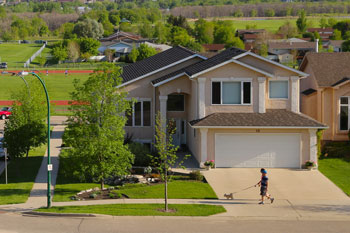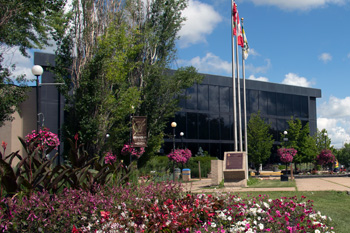
In today’s society, change is taking place at a staggering pace. Traditional thoughts and practices are no longer accepted and are being replaced or improved constantly. Over the past several decades, automobile travel has significantly increased. As arterial streets become congested, motorists search for alternative routes on residential streets. These streets are multi-purpose facilities, shared by pedestrians, cyclists, automobiles, public transit, trucks and service vehicles. For the most part, residential streets co-exist with various users in relative safety and harmony. However, in more and more cases, this is not true for all communities, with some residential streets developing major traffic concerns. These concerns may be related to traffic volume, traffic speed, street geometry, or any combination of issues. The vehicles causing the problems may be local traffic, non-local traffic, or a combination of both. The result is that traffic dominates or impacts in such a way that some residential streets are no longer perceived as pleasant or safe. Neighborhoods invaded by this traffic are losing their identity and livability. When this situation arises, community residents and local officials demand action to address the traffic and safety problems. In some cases these problems can be solved by traditional means, however, traditional means are not able to be applied in today’s world and new solutions must be considered.
A recent trend in cities and municipalities around the world is to implement a concept called Traffic Calming, which assists in resolving traffic and safety issues on residential streets. Traffic calming is heralded by some city planners as the wave of the future. However, traffic calming is not perceived the same way by everyone. This perception results in considerable variation in the way in which traffic calming is defined and the way in which traffic calming measures are applied in different communities.
What is traffic calming? Definitions of traffic calming vary, some include all three “E’s” of traffic education, enforcement, and engineering. Others focus on engineering measures but include all kinds of concepts that compel drivers to slow down. Traffic calming is characterized by the Transportation Association of Canada (TAC) as:
- “the alteration of motorist behavior on an individual roadway or roadway network as well as the management of traffic (changes in routes and flows) within that network.”
The Institute of Traffic Engineers defines traffic calming as
- “the combination of mainly physical features that reduce the negative effects of motor vehicle use, alter driver behavior and improve conditions for non-motorized street users”.
The objective and challenge for those implementing traffic calming is to determine the best combination of measures that result in a net improvement (both real and perceived improvement) in the quality of neighbourhood life at a reasonable cost. Much consideration must be given to various factors such as cost, resident’s opinion, public services (i.e. fire, ambulance, police, snow clearing, transit) before implementing traffic calming. These factors can be the most overlooked aspect when trying to implement traffic calming in communities.
Purpose
The purpose of traffic calming is to restore streets to their intended function. If applied properly, traffic calming techniques allow residential streets to become a more pleasant environment for traffic and pedestrians. On residential streets, traffic calming is intended to achieve one or more of the following objectives:
- To reduce vehicular speeds;
- To discourage the use of residential streets as a means of shortcuts;
- To minimize conflicts between traffic and pedestrians;
- To improve the neighborhood environment by regulating the impact of vehicular traffic;
- To promote safe and pleasant conditions for motorists and residents.
Two types of traffic calming measures exist, one that seeks to control the volumes along a particular roadway / network and the other which seeks to control the speed. A range of traffic calming measures within both types is described below.
Traffic Calming Measures for Volume Control
Volume control measures are intended to direct traffic to the appropriate type of roadway facility based on the intended trip. They are often used to reduce cut-through or pass-through traffic by prohibiting certain movements within a neighbourhood. Non-local traffic would thus be directed to collector or arterial roadways, rather than residential streets. Examples of volume control measures include:
- Partial closures close one direction of travel for a short distance on an otherwise two-way street.
- Full closures completely close the street to through traffic by placing some type of barrier across the roadway, but typically leaving the sidewalks open.
- Diagonal diverters block through movements and create two separate L-shaped streets at an intersection by placing a barrier diagonally across the intersection.
- Right-in/right-out islands are raised concrete islands located at intersections that prohibit a vehicle from turning left or traveling straight through an intersection.
- Raised medians are non-traversable medians within the centre of a roadway that prohibit certain movements from cross streets or driveways.
Parital Closures
Advantage: Very effective at reducing traffic volumes while maintaining two-way pedestrian and bicycle access.
Disadvantage: They may limit residential and commercial access and must be designed to effectively prevent ‘short cuts’ around the barriers.
Full Closures
Advantage: Very effective at reducing traffic volumes while maintaining pedestrian and bicycle access.
Disadvantage: They may be expensive, may limit business and residential access, and could require legal procedures.
Diagonal Diverters
Advantage: They reduce traffic volumes while maintaining an open intersection and providing full pedestrian and bicycle access.
Disadvantage: They may be expensive and would require curb reconstruction. They may also lead to additional travel for local residents and emergency vehicles.
Right In/Right Out Islands
Advantage: Reduce pass-through traffic and decrease traffic volumes, which could improve noise and air quality.
Disadvantage: May lead to additional travel for local residents and emergency vehicles.
Raised Medians
Advantage: Can improve safety by prohibiting dangerous movements while reducing the amount of cut-through traffic that crosses a major street.
Disadvantage: Require sufficient roadway width to accommodate raised median (or expensive reconstruction) and limit turns for local residents and emergency vehicles.
Traffic Calming Measures for Speed Control
Speed control measures are intended to slow the flow of traffic along a particularly roadway by changes in the roadway geometry. These changes could include horizontal curvature, lane widths, and/or vertical elements within the roadway itself. Examples of speed control measures include:
- Speed humps are rounded raised areas that span the width of the roadway. They are typically several metres long, which distinguish them from the much shorter speed bumps
- Speed tables are large speed humps that have a flat top that is typically long enough to accommodate the entire wheelbase of a passenger vehicle. They have slightly higher design speeds than speed humps and can be more aesthetically pleasing.
- Raised crosswalks are simply speed tables that contain crosswalk markings and the appropriate pedestrian signage. They assist in not only slowing traffic, but also create a safer crossing location for pedestrians by raising them above the roadway elevation.
- Textured pavement could include stamped pavement, colour pavement, or alternative paving materials such as bricks or stones. They may be used to highlight an entire area (intersection), or just a portion (crosswalk).
- Roundabouts are raised islands placed at intersections, which prevent traffic from going straight through an intersection.
- Chicanes slow travel speeds by forcing frequent turns by either curb extensions or on-street parking that alternates sides along a roadway to create an s-shaped movement.
- Bulb-outs / chokers
- Center island narrowing are raised islands located in the centre of a street that narrow the travel lanes in one or more directions.
Speed Humps
Advantage: Relatively inexpensive, easily navigable by cyclists and very effective at slowing travel speeds.
Disadvantage: May increase noise and air pollution as well as result in unwanted slowing of emergency vehicles.
Speed Tables
Advantage: Provide a smoother ride for large vehicles (emergency vehicles) and are effective at reducing travel speed, though not as effective as speed humps.
Disadvantage: They may increase noise and air pollution, and their aesthetic components (textured materials) can be expensive.
Raised Crosswalk
Advantage: Improve both pedestrian and vehicle safety and are effective at reducing travel speeds, though again, not as effective as speed humps.
Disadvantage: They may impact drainage needs and may result in increased noise and air pollution.
Textured Pavement
Advantage: Provide a smoother ride for large vehicles (emergency vehicles) and are effective at reducing travel speed, though not as effective as speed humps.
Disadvantage: They may increase noise and air pollution, and their aesthetic components (textured materials) can be expensive.
Roundabouts
Advantage: Very effective a moderating speeds and improving safety.
Disadvantage: Difficult for large vehicles to navigate.
Chicanes
Advantage: Discourage high speeds by forcing frequent turns and are easily negotiable by large vehicles.
Disadvantage: They must be designed appropriately and may be costly to implement (new curb construction).
Bulb-Outs Chokers
Advantage: Easily navigable by large vehicles and reduce both travel speed and volumes.
Disadvantage: Not as effective as reducing speed as other measures due to no/minimal horizontal / vertical deflections, and may require cyclists to merge with vehicular traffic.
Center Island Narrowing
Advantage: They increase pedestrian safety, slow travel speed and may reduce traffic volumes.
Disadvantage: Not as effective as reducing speed as other measures due to no/minimal horizontal / vertical deflections.







